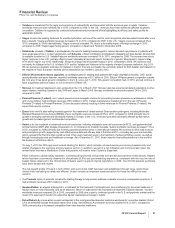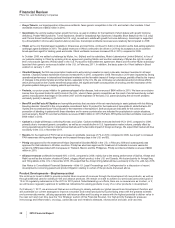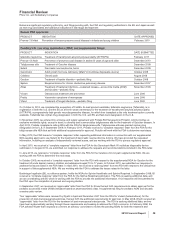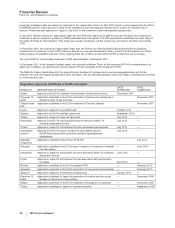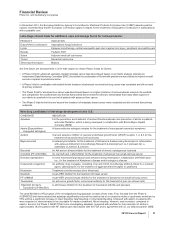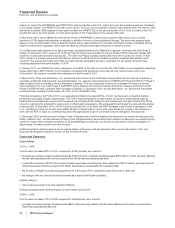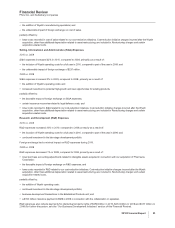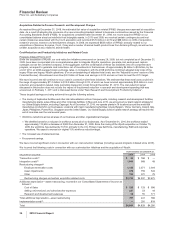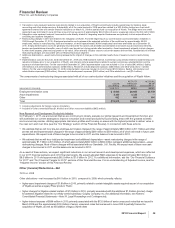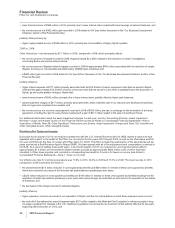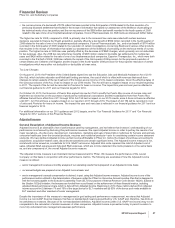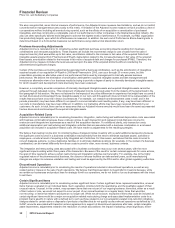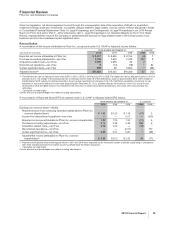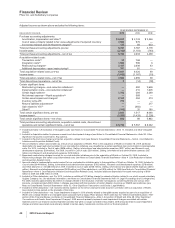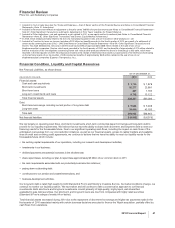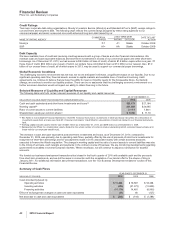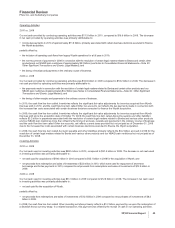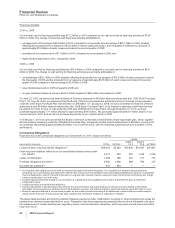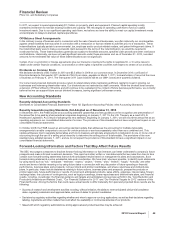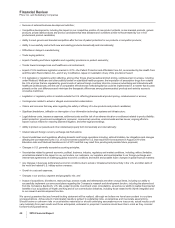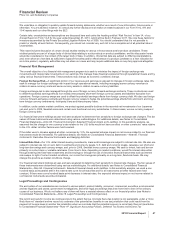Pfizer 2010 Annual Report Download - page 39
Download and view the complete annual report
Please find page 39 of the 2010 Pfizer annual report below. You can navigate through the pages in the report by either clicking on the pages listed below, or by using the keyword search tool below to find specific information within the annual report.
Financial Review
Pfizer Inc. and Subsidiary Companies
•the non-recurrence of a tax benefit of $174 million that was recorded in the third quarter of 2009 related to the final resolution of a
previously disclosed settlement that resulted in the receipt of information that raised our assessment of the likelihood of prevailing on
the technical merits of our tax position, and the non-recurrence of the $556 million tax benefit recorded in the fourth quarter of 2009
related to the sale of one of our biopharmaceutical companies, Vicuron Pharmaceuticals, Inc. Both items are discussed further below.
The higher tax rate for 2009, compared to 2008, is primarily due to the increased tax costs associated with certain business
decisions executed to finance the Wyeth acquisition, partially offset by a tax benefit of $556 million recorded in the fourth quarter of
2009 related to the sale of one of our biopharmaceutical companies, Vicuron Pharmaceuticals, Inc., and a tax benefit of $174 million
recorded in the third quarter of 2009 related to the resolution of certain investigations concerning Bextra and various other products
that resulted in the receipt of information that raised our assessment of the likelihood of prevailing on the technical merits of our tax
position. The higher tax rate in 2009 also was partially offset by the decrease in IPR&D charges, which generally are not deductible
for tax purposes. Also, the 2008 tax rate reflects tax benefits of $305 million related to favorable tax settlements for multiple tax
years and $426 million related to the sale of one of our biopharmaceutical companies, Esperion Therapeutics, Inc., which were both
recorded in the first half of 2008. 2008 also reflects the impact of the third-quarter 2008 provision for the proposed resolution of
certain Bextra and Celebrex civil litigation and the impact of the fourth-quarter 2008 provision for the proposed resolution of certain
investigations which were either not deductible or deductible at lower rates.
Tax Law Changes
On August 10, 2010, the President of the United States signed into law the Education Jobs and Medicaid Assistance Act of 2010
(the Act), which includes education and Medicaid funding provisions, the cost of which is offset with revenues that result from
changes to certain aspects of the tax treatment of the foreign-source income of U.S.-based companies. Given the effective dates of
the various provisions of the Act, it had no impact on our 2010 results. The Act will have a negative impact on our results beginning
in 2011. The impact of the Act will be recorded in Provision for taxes on income. The impact this year and next year is reflected in
our financial guidance for 2011 and our financial targets for 2012.
On October 25, 2010, the Governor of Puerto Rico signed into law Act 154 to modify the Puerto Rico source-of-income rules and
implement an excise tax on the purchase of products by multinational corporations and their subsidiaries from their Puerto Rico
affiliates that will be in effect from 2011 through 2016. Act 154 had no impact on our 2010 results, since it does not become effective
until 2011. Act 154 will have a negative impact on our results in 2011 through 2016. The impact of Act 154 will be recorded in Cost
of sales and Provision for taxes on income. The impact this year and next year is reflected in our financial guidance for 2011 and our
financial targets for 2012.
For additional information on our 2011 guidance and 2012 targets, see the “Our Financial Guidance for 2011” and “Our Financial
Targets for 2012” sections of this Financial Review.
Adjusted Income
General Description of Adjusted Income Measure
Adjusted income is an alternative view of performance used by management, and we believe that investors’ understanding of our
performance is enhanced by disclosing this performance measure. We report Adjusted income in order to portray the results of our
major operations––the discovery, development, manufacture, marketing and sale of prescription medicines for humans and animals,
consumer healthcare (over-the-counter) products, vaccines and nutritional products––prior to considering certain income statement
elements. We have defined Adjusted income as Net income attributable to Pfizer Inc. before the impact of purchase accounting for
acquisitions, acquisition-related costs, discontinued operations and certain significant items. The Adjusted income measure is not,
and should not be viewed as, a substitute for U.S. GAAP net income. Adjusted total costs represent the total of Adjusted cost of
sales, Adjusted SI&A expenses and Adjusted R&D expenses, which are income statement line items prepared on the same basis
as, and are components of, the overall Adjusted income measure.
The Adjusted income measure is an important internal measurement for Pfizer. We measure the performance of the overall
Company on this basis in conjunction with other performance metrics. The following are examples of how the Adjusted income
measure is utilized:
•senior management receives a monthly analysis of our operating results that is prepared on an Adjusted income basis;
•our annual budgets are prepared on an Adjusted income basis; and
•senior management’s annual compensation is derived, in part, using this Adjusted income measure. Adjusted income is one of the
performance metrics utilized in the determination of bonuses under the Pfizer Inc. Executive Annual Incentive Plan that is designed to
limit the bonuses payable to the Executive Leadership Team (ELT) for purposes of Internal Revenue Code Section 162(m). Subject to
the Section 162(m) limitation, the bonuses are funded from a pool based on the achievement of three financial metrics, including
adjusted diluted earnings per share, which is derived from Adjusted income. Beginning in 2010, these metrics derived from Adjusted
income account for (i) between 7% and 13% of the target bonus for ELT members and (ii) 33% of the bonus pool made available to
ELT members and other members of senior management.
Despite the importance of this measure to management in goal setting and performance measurement, we stress that Adjusted
income is a non-GAAP financial measure that has no standardized meaning prescribed by U.S. GAAP and, therefore, has limits in
its usefulness to investors. Because of its non-standardized definition, Adjusted income (unlike U.S. GAAP net income) may not be
comparable to the calculation of similar measures of other companies. Adjusted income is presented solely to permit investors to
more fully understand how management assesses performance.
2010 Financial Report 37


